Abstract
We studied the effectiveness of the PCR in detecting the type A, B, and E botulism neurotoxin genes in 209 strains of Clostridium botulinum and 29 strains of other Clostridium spp. All 79 strains that produced type A toxin, 77 strains that produced type B toxin, and 51 organisms that produced type E toxin (46 C. botulinum and 5 C. butyricum) were PCR positive in reactions with primers targeting sequences specific for their respective toxin genes. The PCR for type A toxin was positive for one type B toxin-producing strain that produced a small amount of type A toxin in addition to a large amount of type B toxin. Surprisingly, the type B toxin gene was detected in addition to the type A toxin gene in 43 type A toxin-producing strains, only 1 of which could be shown by bioassay to produce biologically active type B toxin in culture. The type B gene was also detected in two strains of C. subterminale, which were determined to be nontoxigenic by bioassay. While the PCR was sensitive and specific in detecting the neurotoxin genes, the discovery of unexpressed toxin genes indicates that PCR results may not be adequate for establishing type B neurotoxigenicity.
Full text
PDF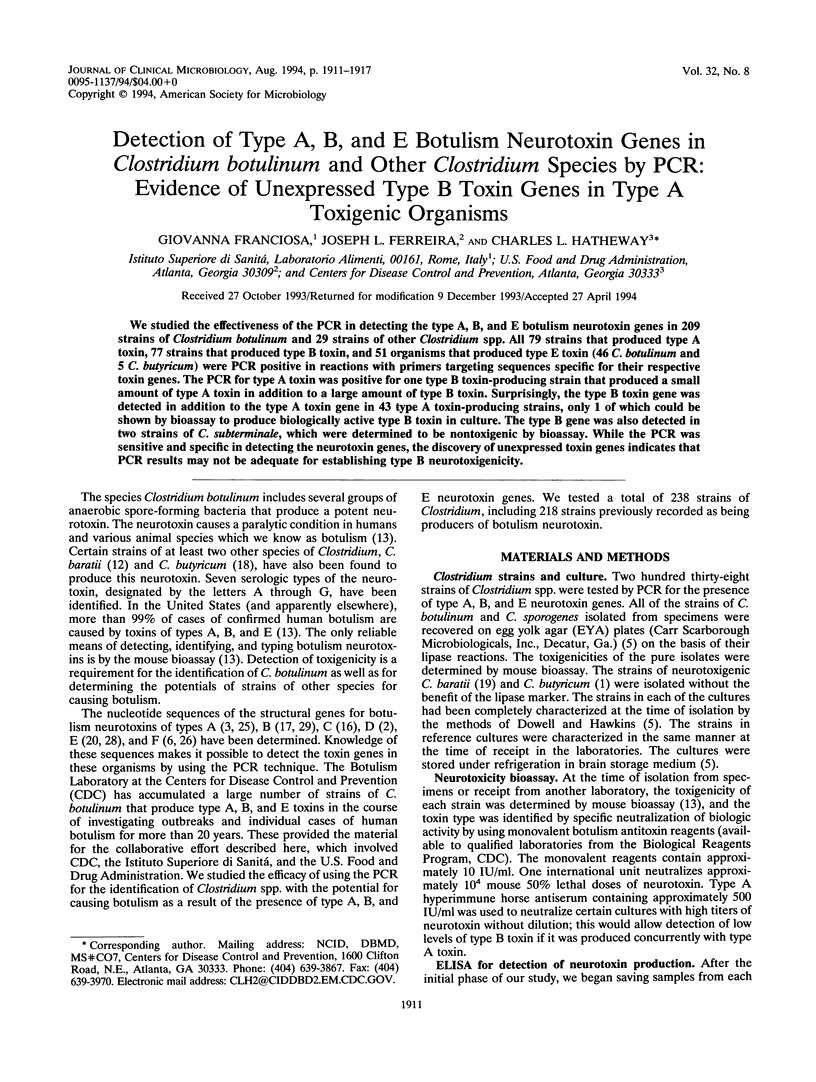
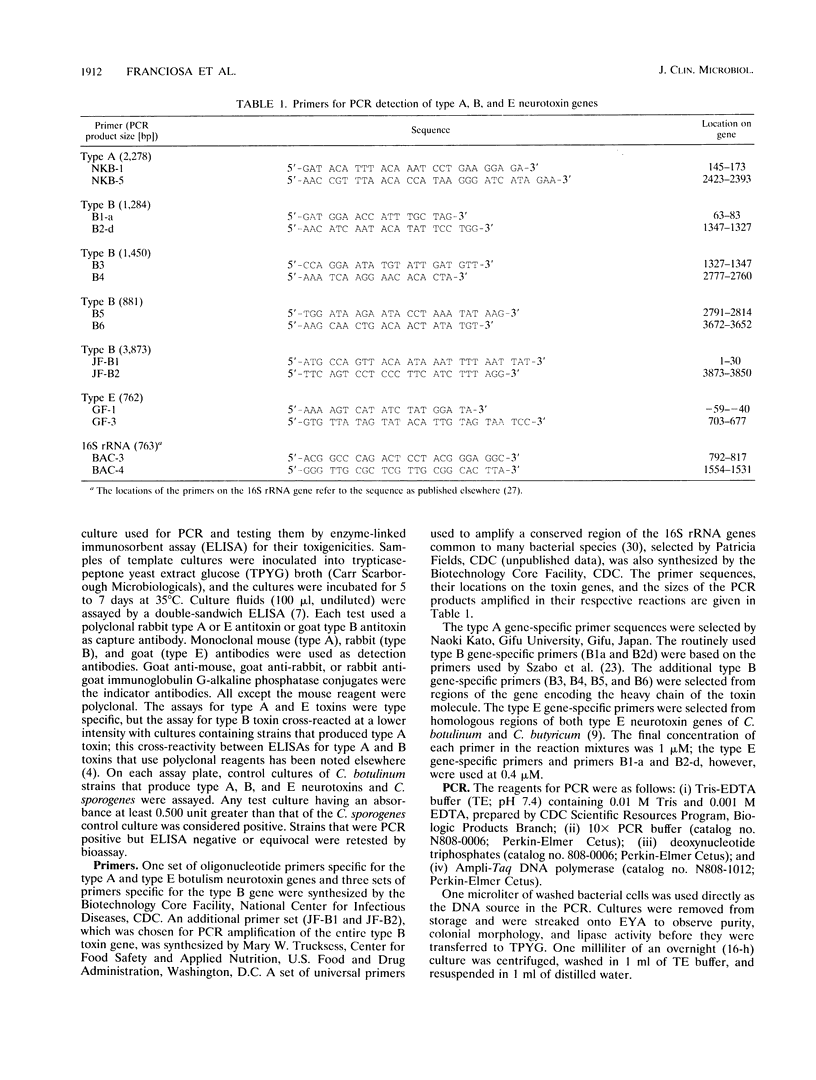
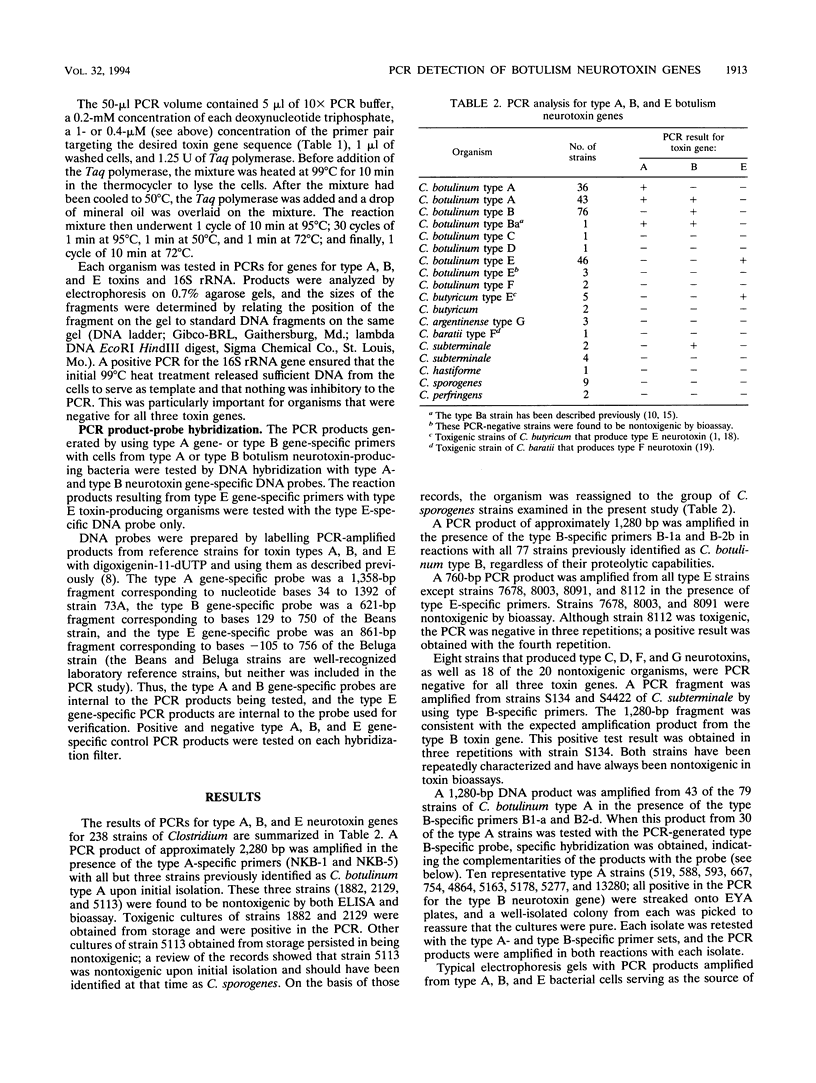
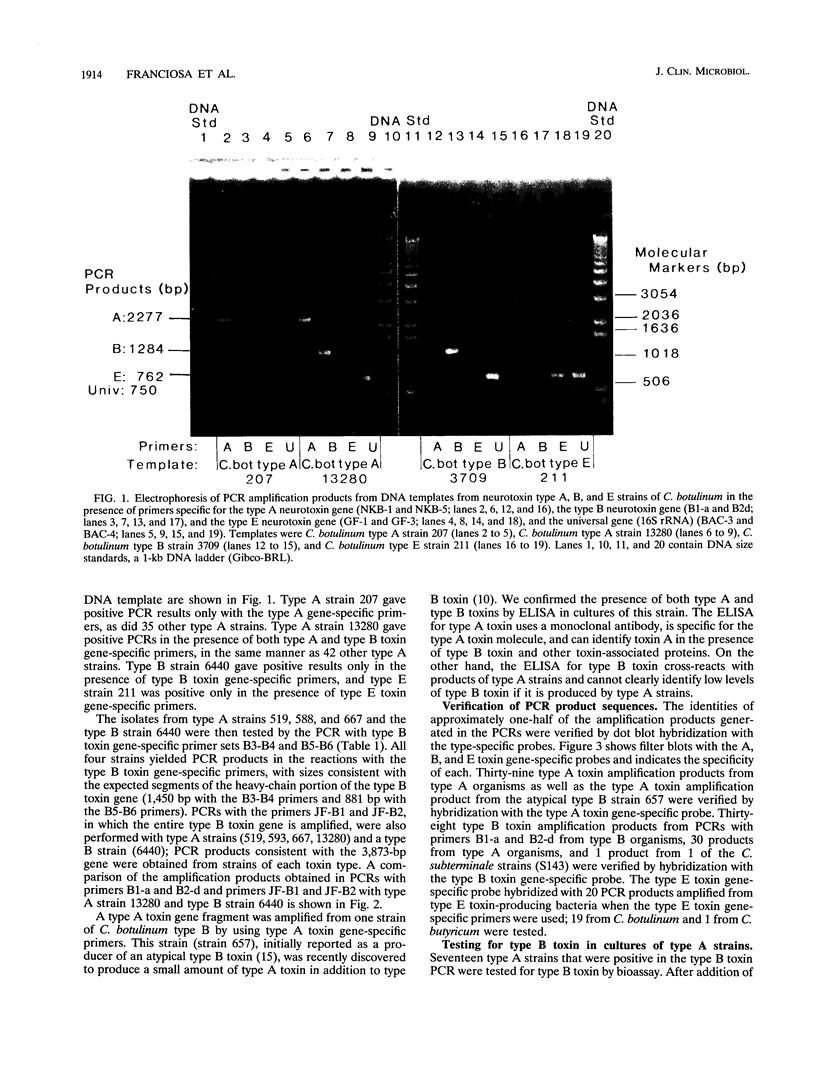
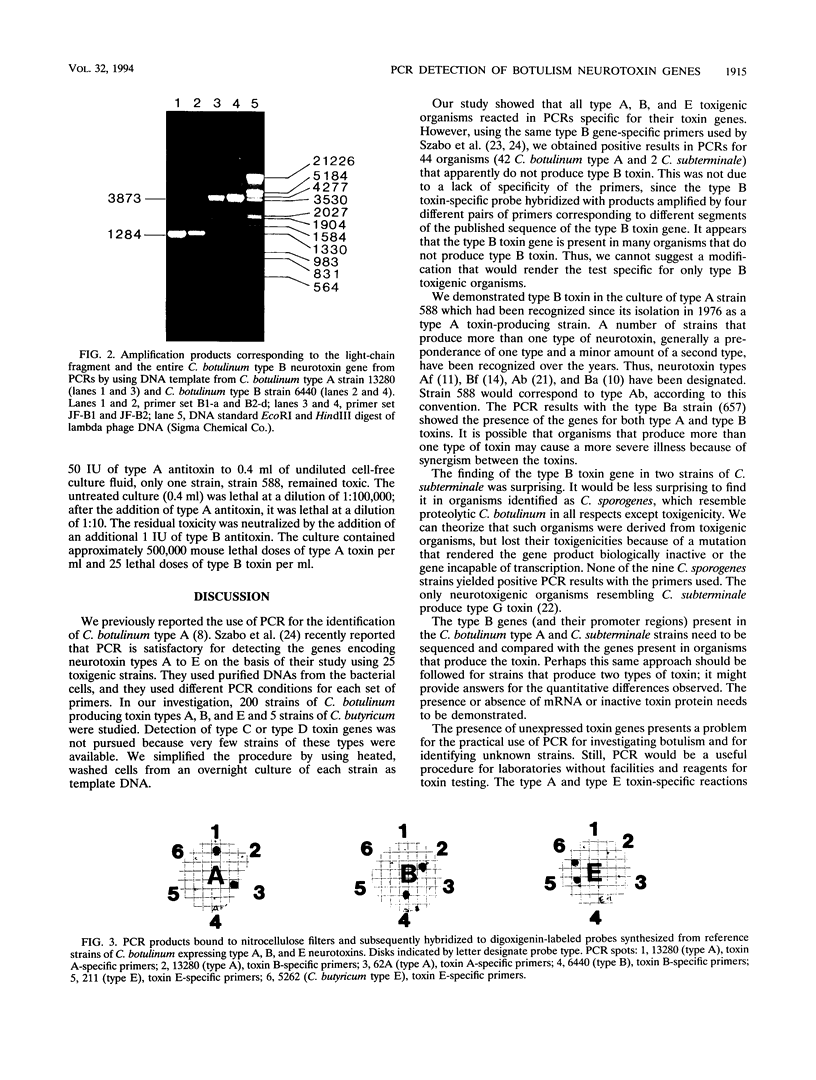
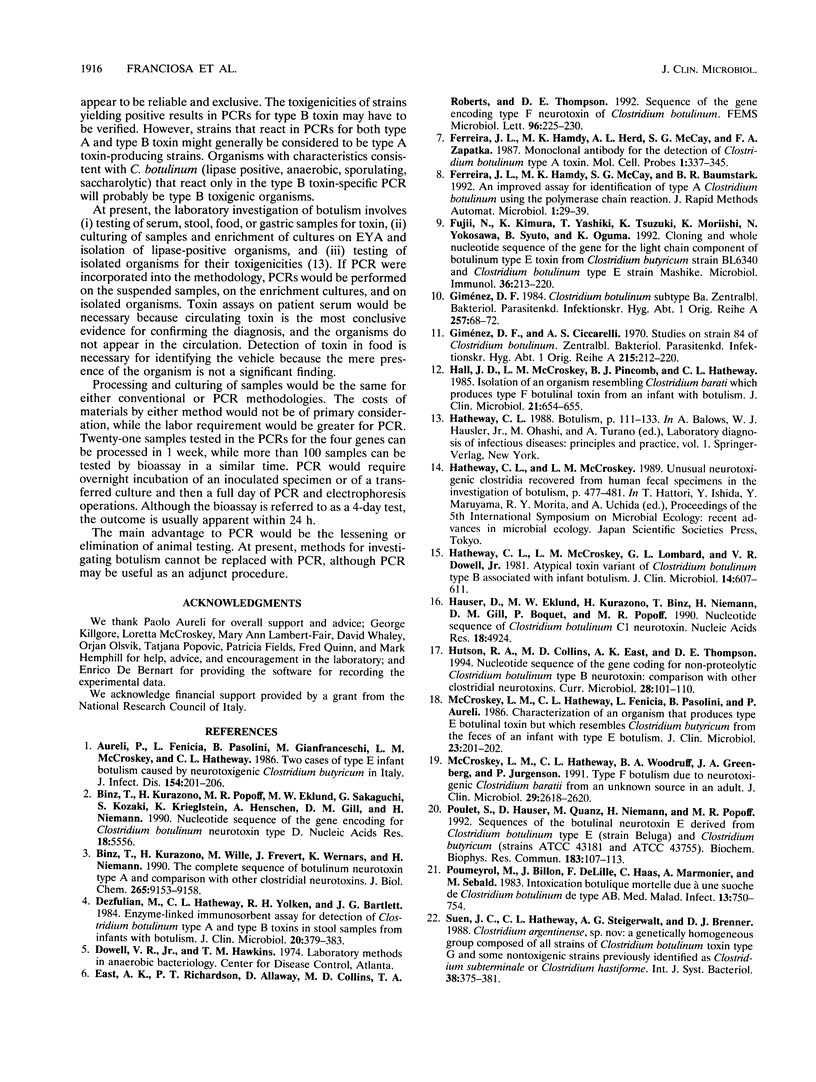
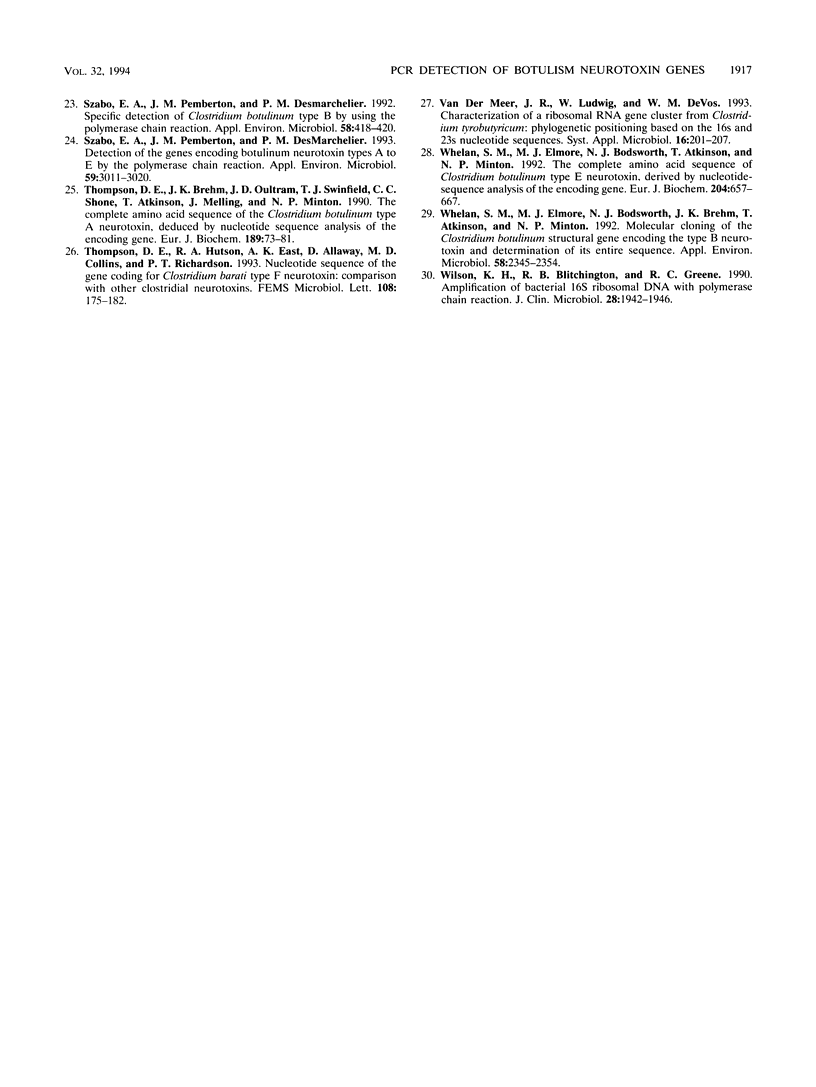
Images in this article
Selected References
These references are in PubMed. This may not be the complete list of references from this article.
- Arnon S. S. Infant botulism: anticipating the second decade. J Infect Dis. 1986 Aug;154(2):201–206. doi: 10.1093/infdis/154.2.201. [DOI] [PubMed] [Google Scholar]
- Binz T., Kurazono H., Popoff M. R., Eklund M. W., Sakaguchi G., Kozaki S., Krieglstein K., Henschen A., Gill D. M., Niemann H. Nucleotide sequence of the gene encoding Clostridium botulinum neurotoxin type D. Nucleic Acids Res. 1990 Sep 25;18(18):5556–5556. doi: 10.1093/nar/18.18.5556. [DOI] [PMC free article] [PubMed] [Google Scholar]
- Binz T., Kurazono H., Wille M., Frevert J., Wernars K., Niemann H. The complete sequence of botulinum neurotoxin type A and comparison with other clostridial neurotoxins. J Biol Chem. 1990 Jun 5;265(16):9153–9158. [PubMed] [Google Scholar]
- Dezfulian M., Hatheway C. L., Yolken R. H., Bartlett J. G. Enzyme-linked immunosorbent assay for detection of Clostridium botulinum type A and type B toxins in stool samples of infants with botulism. J Clin Microbiol. 1984 Sep;20(3):379–383. doi: 10.1128/jcm.20.3.379-383.1984. [DOI] [PMC free article] [PubMed] [Google Scholar]
- East A. K., Richardson P. T., Allaway D., Collins M. D., Roberts T. A., Thompson D. E. Sequence of the gene encoding type F neurotoxin of Clostridium botulinum. FEMS Microbiol Lett. 1992 Sep 15;75(2-3):225–230. doi: 10.1016/0378-1097(92)90408-g. [DOI] [PubMed] [Google Scholar]
- Ferreira J. L., Hamdy M. K., Herd Z. L., McCay S. G., Zapatka F. A. Monoclonal antibody for the detection of Clostridium botulinum type A toxin. Mol Cell Probes. 1987 Dec;1(4):337–345. doi: 10.1016/0890-8508(87)90015-6. [DOI] [PubMed] [Google Scholar]
- Fujii N., Kimura K., Yashiki T., Tsuzuki K., Moriishi K., Yokosawa N., Syuto B., Oguma K. Cloning and whole nucleotide sequence of the gene for the light chain component of botulinum type E toxin from Clostridium butyricum strain BL6340 and Clostridium botulinum type E strain Mashike. Microbiol Immunol. 1992;36(3):213–220. doi: 10.1111/j.1348-0421.1992.tb01659.x. [DOI] [PubMed] [Google Scholar]
- Giménez D. F., Ciccarelli A. S. Studies on strain 84 of Clostridium botulinum. Zentralbl Bakteriol Orig. 1970;215(2):212–220. [PubMed] [Google Scholar]
- Giménez D. F. Clostridium botulinum subtype Ba. Zentralbl Bakteriol Mikrobiol Hyg A. 1984 May;257(1):68–72. [PubMed] [Google Scholar]
- Hall J. D., McCroskey L. M., Pincomb B. J., Hatheway C. L. Isolation of an organism resembling Clostridium barati which produces type F botulinal toxin from an infant with botulism. J Clin Microbiol. 1985 Apr;21(4):654–655. doi: 10.1128/jcm.21.4.654-655.1985. [DOI] [PMC free article] [PubMed] [Google Scholar]
- Hatheway C. L., McCroskey L. M., Lombard G. L., Dowell V. R., Jr Atypical toxin variant of Clostridium botulinum type B associated with infant botulism. J Clin Microbiol. 1981 Dec;14(6):607–611. doi: 10.1128/jcm.14.6.607-611.1981. [DOI] [PMC free article] [PubMed] [Google Scholar]
- Hauser D., Eklund M. W., Kurazono H., Binz T., Niemann H., Gill D. M., Boquet P., Popoff M. R. Nucleotide sequence of Clostridium botulinum C1 neurotoxin. Nucleic Acids Res. 1990 Aug 25;18(16):4924–4924. doi: 10.1093/nar/18.16.4924. [DOI] [PMC free article] [PubMed] [Google Scholar]
- Hutson R. A., Collins M. D., East A. K., Thompson D. E. Nucleotide sequence of the gene coding for non-proteolytic Clostridium botulinum type B neurotoxin: comparison with other clostridial neurotoxins. Curr Microbiol. 1994 Feb;28(2):101–110. doi: 10.1007/BF01569055. [DOI] [PubMed] [Google Scholar]
- McCroskey L. M., Hatheway C. L., Fenicia L., Pasolini B., Aureli P. Characterization of an organism that produces type E botulinal toxin but which resembles Clostridium butyricum from the feces of an infant with type E botulism. J Clin Microbiol. 1986 Jan;23(1):201–202. doi: 10.1128/jcm.23.1.201-202.1986. [DOI] [PMC free article] [PubMed] [Google Scholar]
- McCroskey L. M., Hatheway C. L., Woodruff B. A., Greenberg J. A., Jurgenson P. Type F botulism due to neurotoxigenic Clostridium baratii from an unknown source in an adult. J Clin Microbiol. 1991 Nov;29(11):2618–2620. doi: 10.1128/jcm.29.11.2618-2620.1991. [DOI] [PMC free article] [PubMed] [Google Scholar]
- Poulet S., Hauser D., Quanz M., Niemann H., Popoff M. R. Sequences of the botulinal neurotoxin E derived from Clostridium botulinum type E (strain Beluga) and Clostridium butyricum (strains ATCC 43181 and ATCC 43755). Biochem Biophys Res Commun. 1992 Feb 28;183(1):107–113. doi: 10.1016/0006-291x(92)91615-w. [DOI] [PubMed] [Google Scholar]
- Szabo E. A., Pemberton J. M., Desmarchelier P. M. Detection of the genes encoding botulinum neurotoxin types A to E by the polymerase chain reaction. Appl Environ Microbiol. 1993 Sep;59(9):3011–3020. doi: 10.1128/aem.59.9.3011-3020.1993. [DOI] [PMC free article] [PubMed] [Google Scholar]
- Szabo E. A., Pemberton J. M., Desmarchelier P. M. Specific detection of Clostridium botulinum type B by using the polymerase chain reaction. Appl Environ Microbiol. 1992 Jan;58(1):418–420. doi: 10.1128/aem.58.1.418-420.1992. [DOI] [PMC free article] [PubMed] [Google Scholar]
- Thompson D. E., Brehm J. K., Oultram J. D., Swinfield T. J., Shone C. C., Atkinson T., Melling J., Minton N. P. The complete amino acid sequence of the Clostridium botulinum type A neurotoxin, deduced by nucleotide sequence analysis of the encoding gene. Eur J Biochem. 1990 Apr 20;189(1):73–81. doi: 10.1111/j.1432-1033.1990.tb15461.x. [DOI] [PubMed] [Google Scholar]
- Thompson D. E., Hutson R. A., East A. K., Allaway D., Collins M. D., Richardson P. T. Nucleotide sequence of the gene coding for Clostridium barati type F neurotoxin: comparison with other clostridial neurotoxins. FEMS Microbiol Lett. 1993 Apr 1;108(2):175–182. doi: 10.1111/j.1574-6968.1993.tb06095.x. [DOI] [PubMed] [Google Scholar]
- Whelan S. M., Elmore M. J., Bodsworth N. J., Atkinson T., Minton N. P. The complete amino acid sequence of the Clostridium botulinum type-E neurotoxin, derived by nucleotide-sequence analysis of the encoding gene. Eur J Biochem. 1992 Mar 1;204(2):657–667. doi: 10.1111/j.1432-1033.1992.tb16679.x. [DOI] [PubMed] [Google Scholar]
- Whelan S. M., Elmore M. J., Bodsworth N. J., Brehm J. K., Atkinson T., Minton N. P. Molecular cloning of the Clostridium botulinum structural gene encoding the type B neurotoxin and determination of its entire nucleotide sequence. Appl Environ Microbiol. 1992 Aug;58(8):2345–2354. doi: 10.1128/aem.58.8.2345-2354.1992. [DOI] [PMC free article] [PubMed] [Google Scholar]
- Wilson K. H., Blitchington R. B., Greene R. C. Amplification of bacterial 16S ribosomal DNA with polymerase chain reaction. J Clin Microbiol. 1990 Sep;28(9):1942–1946. doi: 10.1128/jcm.28.9.1942-1946.1990. [DOI] [PMC free article] [PubMed] [Google Scholar]




